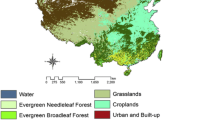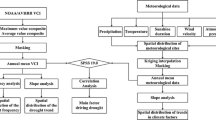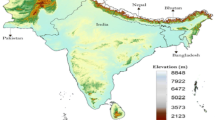Abstract
Drought is a complex natural phenomenon that can cause reduced water supplies and can consequently have substantial effects on agriculture and socioeconomic activities. The objective of this study was to gain a better understanding of the spatial-temporal variation characteristics of vegetative drought and its relationship with meteorological factors in China. The Vegetation Condition Index (VCI) dataset calculated from NOAA/AVHRR images from 1982 to 2010 was used to analyse the spatial-temporal variation characteristics of vegetative drought in China. This study also examined the trends in meteorological factors and their influences on drought using monitoring data collected from 686 national ground meteorological stations. The results showed that the VCI appeared to slowly rise in China from 1982 to 2010. From 1982 to 1999, the VCI rose slowly. Then, around 2000, the VCI exhibited a severe fluctuation before it entered into a relatively stable stage. Drought frequencies in China were higher, showing a spatial distribution feature of “higher in the north and lower in the south”. Based on the different levels of drought, the frequencies of mild and moderate drought in four geographical areas were higher, and the frequency of severe drought was higher only in ecologically vulnerable areas, such as the Tarim Basin and the Qaidam Basin. Drought was mainly influenced by meteorological factors, which differed regionally. In the northern region, the main influential factor was sunshine duration, while the other factors showed minimal effects. In the southern region and Tibetan Plateau, the main influential factors were sunshine duration and temperature. In the northwestern region, the main influential factors were wind velocity and station atmospheric pressure.







Similar content being viewed by others
References
Aalto, J., Pirinen, P., Heikkinen, J., & Venäläinen, A. (2013). Spatial interpolation of monthly climate data for Finland: comparing the performance of kriging and generalized additive models. Theoretical and Applied Climatology, 112, 99–111.
Bajgiran, P. R., Darvishsefat, A. A., Khalili, A., & Makhdoum, M. F. (2008). Using AVHRR-based vegetation indices for drought monitoring in the northwest of Iran. Journal of Arid Environments, 72(6), 1086–1096.
Bandyopadhyay, N., & Saha, A. K. (2016). A comparative analysis of four drought indices using geospatial data in Gujarat, India. Arabian Journal of Geosciences, 9, 341.
Cai, B., Lu, W. J., & Zhang, X. J. (1995). Using meteorological satellites VCI to monitor soil state. Remote Sensing for land & Resources, 4(26), 45–50.
Choi, M., Jacobs, J. M., Anderson, M. C., & Bosch, D. D. (2013). Evaluation of drought indices via remotely sensed data with hydrological variables. Journal of Hydrology, 476, 265–273.
Cunha, A. P. M., Alvala, R. C., Nobre, C. A., & Carvalho, M. A. (2015). Monitoring vegetative drought dynamics in the Brazilian semiarid region. Agricultural and Forest Meteorology, 214-215, 494–505.
Dai, A. (2011). Characteristics and trends in various forms of the Palmer Drought Severity Index during 1900-2008. Journal of Geophysical Research, 116, 1–26.
Feng, Q., Tian, G. L., & Liu, Q. H. (2003). Research on the operational system of drought monitoring by remote sensing in China. Journal of Remote Sensing, 7(1), 14–18.
Feng, Q., Tian, G. L., Wang, A. S., McVicar, T. R., & Jupp, D. L. B. (2004). Remote sensing monitoring of soil humidity using vegetation condition index. Journal of Natural Disasters, 13(3), 81–88.
Gao, Y. H., Xu, Y. J., Yang, S. Q., Liu, C., & Ni, B. S. (2013). Research and design of a drought remote sensing monitoring system based on the ArcGIS geoprocessing technology. Journal of Southwest University(natural science edition), 35(4), 1–7.
Goovaerts, P. (1997). Geostatistics for natural resources evaluation, Applied geostatistics series. Oxford: Oxford University Press.
Guan, X. D., Guo, N., Huang, J. P., Ge, J. P., & Zheng, Z. H. (2008). Applicability analysis of VCI to monitoring northwest China drought. Plateau Meteorology, 27(5), 1046–1053.
Guo, N., & Guan, X. D. (2007). An improvement of the Vegetation Condition Index with applications to the drought monitoring in northwest China. Advance in Earth Science, 22(11), 1160–1168.
Hao, Z. C., & AghaKouchak, A. (2013). Multivariate Standardized Drought Index: a parametric multi-index model. Advances in Water Resources, 57, 12–18.
Hou, Y. Y., He, Y. B., Liu, Q. H., & Tian, G. L. (2007). Research progress on drought dices. Chinese Journal of Ecology, 26(6), 892–897.
Huang, R. H., Xu, Y. H., & Zhou, L. T. (1999). The inter-decadal variation of summer precipitations in China and the drought trend in north China. Plateau meteorology, 18(4), 465–476.
Johnson, G. E., Achutuni, V. R., Thiruvengadachari, S., & Kogan, F. N. (1993). The role of NOAA satellite data in drought early warning and monitoring: selected case studies. In D. A. Wilhite (Ed.), Drought assessment, management and planning: theory and case studies. Dordrecht: Kluwer Academic Publishers.
Khayyati, M., & Aazami, M. (2016). Drought impact assessment on rural livelihood systems in Iran. Ecological Indicators, 69, 850–858.
Kogan, K. N. (1990). Remote sensing of weather impacts on vegetations in non-homogeneous areas. International Journal of Remote Sensing, 11(8), 1405–1419.
Kogan, F. N. (1995). Droughts of the late 1980s in the United States as derived from NOAA polar-orbiting satellite data. Bulletin of the American Meteorological Society, 76(5), 655–668.
Kong, L. F., & Yang, X. Y. (2014). Analysis of drought in Yunnan: causes and countermeasures. Journal of Dali University, 13(12), 52–55.
Kuang, Z. M., Zhu, W. J., Yang, X., Huang, Y. L., He, L., & Sun, H. (2007). Study on drought index model of arid area in central Guangxi based on MODIS data. Journal of Nanjing Institute of Meteorology, 30(3), 354–358.
Li, Z., Zhou, T., Zhao, X., Huang, K. C., Wu, H., & Du, L. (2016). Diverse spatial-temporal responses in vegetation growth to droughts in China. Environmental Earth Sciences, 75(1), 1–13.
Liang, L., Zhao, S. H., Qin, Z. H., He, K. X., Chen, C., Luo, Y. X., & Zhou, X. D. (2014). Drought change trend using MODIS TVDI and its relationship with climate factors in China from 2001 to 2010. Journal of Integrative Agriculture, 13(7), 1501–1508.
Liang, L., Di, L. P., Zhang, L. P., Deng, M. X., Qin, Z. H., Zhao, S. H., & Lin, H. (2015). Estimation of crop LAI using hyperspectral vegetation indices and a hybrid inversion method. Remote Sensing of Environment, 165(8), 123–134.
Liang, L., Qin, Z. H., Zhao, S. H., Di, L. P., Zhang, C., Deng, M. X., Lin, H., Zhang, L. P., Wang, L. J., & Liu, Z. X. (2016). Estimating crop chlorophyll content with hyperspectral vegetation indices and the hybrid inversion method. International Journal of Remote Sensing, 37(13), 2923–2949.
Liang, L., Sun, Q., Luo, X., Wang, J. H., Zhang, L. P., Deng, M. X., Di, L. P., & Liu, Z. X. (2017). Long-term spatial and temporal variations of vegetative drought based on vegetation condition index in China. Ecosphere, 8(8), e01919.
Lin, Y., Gao, W., Shi, J. P., & Wang, J. (2014). Remote sensing monitoring of drought based on MODIS and FY-2D satellite rainfall data. Journal of Arid Land Resources and Environment, 28(12), 51–57.
Liu, W. T., & Kogan, F. N. (1996). Monitoring regional drought using the Vegetation Condition Index. International Journal of Remote Sensing, 17(14), 2761–2782.
Liu, Z. M., Zhang, B., Yan, M., & Li, T. Q. (2003). Some research advances and trends on soil moisture and drought monitoring by remote sensing. Advance in Earth Science, 18(4), 576–581.
Long, Y., Xie, Q. M., Zhong, M. S., Lu, L., & Li, X. H. (2012). Research on trend removing methods in preprocessing analysis of blasting vibration monitoring signals. Engineering Mechanics, 29(10), 63–68.
Lv, J. (2013). Drought issues in China and new ideas in drought management. China Water Resources, 8, 7–13.
Mendicino, G., Senatore, A., & Versace, P. (2008). A Groundwater Resources Index (GRI) for drought monitoring and forecasting in a Mediterranean climate. Journal of Hydrology, 357, 282–302.
Mirabbasi, R., Anagnostou, E. N., Fakheri-Fard, A., Dinpashoh, Y., & Eslamian, S. (2013). Analysis of meteorological drought in northwest Iran using the Joint Deficit Index. Journal of Hydrology, 492, 35–48.
Paulo, A. A., Rosa, R. D., & Pereira, L. S. (2012). Climate trends and behavior of drought indices based on precipitation and evapotranspiration in Portugal. Natural Hazards and Earth System Sciences, 12(5), 1481–1491.
Peters, A. J., Walter-Shea, E. A., Ji, L., Vina, A., Hayes, M., & Svoboda, M. D. (2002). Drought monitoring with NDVI-based standardized vegetation index. Photogrammeric Engineering and Remote Sensing, 68(1), 71–75.
Qian, X. J., Liang, L., Shen, Q., Sun, Q., Zhang, L. P., Liu, Z. X., Zhao, S. H., & Qin, Z. H. (2016). Drought trends based on the VCI and its correlation with climate factors in the agricultural areas of china from 1982 to 2010. Environmental Monitoring and Assessment, 188(11), 639.
Quiring, S. M., & Ganesh, S. (2010). Evaluating the utility of the Vegetation Condition Index (VCI) for monitoring meteorological drought in Texas. Agricultural and Forest Meteorology, 150(3), 330–339.
Robel, J. & Graumann, A. (2014). NOAA KLM User’s Guide: Section 4. April 2014 Revision. It is available online at: http://noaasis.noaa.gov/NOAASIS/ml/avhrr.html.
Rulinda, C. M., Dilo, A., Bijker, W., & Stein, A. (2012). Characterising and quantifying vegetative drought in East Africa using fuzzy modeling and NDVI data. Journal of Arid Environments, 78, 169–178.
Rulinda, C. M., Stein, A., & Turdukulov, U. D. (2013). Visualizing and quantifying the movement of vegetative drought using remote-sensing data and GIS. International Journal of Geographical Information Science, 27(8), 1481–1496.
Sha, S., Guo, N., Li, Y. H., Ren, Y. L., & Li, Y. P. (2013). Comparison of the vegetation condition index with meteorological drought indices: a case study in Henan province. Journal of Glaciology and Geocryology, 35(4), 990–998.
Shiferaw, B., Tesfaye, K., Kassie, M., Abate, T., Prasanna, B. M., & Menkir, A. (2014). Managing vulnerability to drought and enhancing livelihood resilience in sub-Saharan Africa: technological, institutional and policy options. Weather and Climate Extremes, 3, 67–79.
Sun, Y. L., & Guo, P. (2012). Spatiotemporal variation of vegetation coverage index in north China during the period from 1982–2006. Arid Zone Research, 29(2), 187–193.
Sun, L., Wang, F., Li, B. G., & Chen, X. W. (2014). Study on drought monitoring of Wuling mountain area based on multi-source data. Transactions of the Chinese Society for Agricultural Machinery, 45(1), 246–252.
United Nations Office for Disaster Risk Reduction (UNISDR) (2016). The Human Cost of the Hottest Year on Record—Climate Change and El Nino Drove Disasters Worldwide in 2015. http://www.preventionweb.net/news/view/47795.
Wang, P. X., Gong, J. Y., & Li, X. W. (2001). Vegetation temperature condition index and its application for drought monitoring. Geomatics and Information Science of Wuhan University, 26(5), 412–418.
Wu, X. P., & Wang, F. M. (2008). The research of trend remove based on the principle of least-squares method. Microcomputer Information, 24(10–3), 254–255.
Xu, H. Y., Jia, J. H., Liu, L. Y., Peng, D. L., Li, C. J., & Wu, Y. P. (2015). Drought monitoring in Huang-Huai-Hai plain using the multi-drought indices. Remote Sensing Technology and Application, 30(1), 25–32.
Yan, L. K. (2003). Application of correlation coefficient in related analysis. Journal of Yunnan University of Finance and Economics, 19(3), 78–80.
Yan, N., Du, J. W., Li, D. K., & Yan, J. P. (2008). Progress in research and application of drought method by remote sensing. Journal of Catastrophology, 23(4), 117–121.
Yan, Y., Xiao, F., Du, Y., Ling, F., Li, X. D., & Li, Y. Z. (2012). Monitoring droughts in the five provinces along the middle-lower reaches of the Yangtze river during spring/summer 2011 using AVCI. Resources and Environment in the Yangtze basin, 21(9), 1154–1159.
Yang, B., Ma, S., Wang, B. W., Li, J., & Liao, Y. F. (2012). Agricultural drought monitoring model based on MODIS data in Hunan province. Journal of Natural Resources, 27(10), 1788–1796.
Zhang, Y. D., Zhang, X. H., & Liu, S. R. (2011). Correlation analysis on normalized difference vegetation (NDVI) of different vegetations and climatic factors in Southwest China. Chinese Journal of Applied Ecology, 22(2), 323–330.
Zou, X. K., & Zhang, Q. (2008). Preliminary studies on variations in droughts over China during past 50 years. Journal of applied meteorological science, 19(6), 679–687.
Acknowledgements
The authors particular thank the geospatial data cloud for providing the basic data. The authors also wish to thank Miss Xiaojin Qian, Miss Jiahui Wang and Miss Jialing Li from the School of Geography, Geomatics and Planning, Jiangsu Normal University, China, for their assistance in the revision of the manuscript.
Funding
This research is supported by the National Science Foundation of China (no. 41401473 and no. 31560130), the project funded by the Priority Academic Program Development of Jiangsu Higher Education Institutions (PAPD), the Ecological Civilization Construction Planning Project of Xuzhou (no. XZGTKJ2016011), and the National Innovation and Entrepreneurship Training Program for Undergraduates (no. 201610320004Z).
Author information
Authors and Affiliations
Corresponding author
Ethics declarations
Conflicts of interest
The authors declare that they have no conflicts of interest.
Rights and permissions
About this article
Cite this article
Shen, Q., Liang, L., Luo, X. et al. Analysis of the spatial-temporal variation characteristics of vegetative drought and its relationship with meteorological factors in China from 1982 to 2010. Environ Monit Assess 189, 471 (2017). https://doi.org/10.1007/s10661-017-6187-9
Received:
Accepted:
Published:
DOI: https://doi.org/10.1007/s10661-017-6187-9




